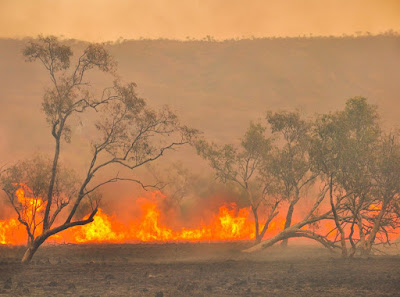Since
they began back in the fall, the news of the fires in Australia has been ceaselessly appalling.The sheer volume of the devastation is nearly impossible to comprehend –
a billion animals have been killed! The human death toll rose again today with the news that
three American firefighters were killed when their air tanker went down. The emotional and societal effects have been enormous as well. On the ground, in people’s homes and in their communities, there has been
much controversy over who or what’s to blame, as well as the level of governmental help that’s been laid out.
Here’s a video that explains one side of the “how did this happen” question. The worry and stress is annihilating. One of my closest friends is from the Melbourne area and she has not been able to rest with the constantly changing fire situation on and around her family’s properties. Thankfully, while the fires are not over, weather and firefighters (or “firies” as the Aussie’s call them) may have turned the corner on some of the larger blazes.

With all the disastrous news swirling about, it may be hard for some people to think there is anything good happening Down Under. This Sunday, January 26, is
Australia Day – a day that they celebrate all things Australian. In honor of their special day, I’ve decided to spread some good Aussie news in this blog.
 |
| Wollemi Pine |
Dinosaur trees: In an undisclosed location in
New South Wales, there is a grove of
ancient Wollemi Pine trees. Known as Dinosaur trees since they flourished alongside those giants, these trees lived as far back as 200 million years ago and exist nowhere else on Earth. Scientists were aware of the fossil record, but thought they were extinct until a forest worker stumbled across a grove of them in 1994. The decision was made to keep the trees’ location secret to keep them safe from the diseases and damage that visitors could bring. As the recent fires approached the grove, the government surreptitiously sent out a specialized team of firefighters to implement safety measures. It was a
Zero Dark Thirty moment in the conservation world and was a tremendous success. The fire retardant they’d sprayed and the irrigation system they’d installed did the job and the grove was saved. For all involved in this special-ops mission, it meant much more than saving a couple hundred trees. It was all about preserving something uniquely ancient Australian and a source of great national pride.
 |
| Smudge |
Let’s talk dogs: Unsurprising (Man’s best friend and all) but still wonderful are the stories of heroic dogs that have come out of these fires. There is Patsy (#patsythecorryongwonderdog), a terrier-shepherd mix, who brought her entire herd of sheep to safety (through the darkness of night) ahead of the fire. She is one good dog and just adorable; check her story out
here. Then there are the
Koala Dogs. Australia has been using dogs to find koalas (and other native species) for some time and are rightfully proud of what they can do. Up to now, though, their training was mostly for research and conservation purposes. But their particular skills have proven excellent for finding injured koalas in burn areas. Humans simply cannot do what these working dogs can. Watch Koala Dog Smudge in action
here. For an update on how some rescued koalas are doing, see
this article.
 Wombats
Wombats: For a minute there, there were stories that went viral about the Australian native wombats herding other animals into their burrows for safety from the fires. But this is only partially true. Wombats dig massive underground warrens with interconnecting burrows that go on and on and have multiple entrances. They move around this underground world, sleeping and doing their wombat thing in various parts of the structure. They don’t seem to mind if some animals come and use the burrows while they are somewhere else (but, they don’t like to share with other wombats, foxes or dogs). So when the fires came, there were many small creatures that knew where to find shelter. Of course, no one knows exactly how it all went down down there. Perhaps they were like humans at a hurricane party – locked down and partying until the worst happened or it was all over.
Here is an excellent article on all this, including a video of burrow visitors. All in all, wombat burrows have been good news for many critters.
 |
| Sidney Opera House Honoring The Firies |
People have truly stepped up: All across Australia – and the world – people have been donating their time and money to help wildlife, firefighters and recovery efforts. Many A-list celebrities have been
digging into their deep pockets and giving substantial amounts. But, it is the everyday people that I find impressive. Australian comedian Celeste Barber began an online fundraiser that garnered $30 million in just one week (an amazing $10,000 a minute). Others are out there feeding firefighters or establishing food and watering stations for displaced animals. When the call went out for
mittens for burnt paws the response was overwhelming and worldwide. In fact, they received so many that they had to put a hold on the handmade donations. And crafters sent money instead. In case you haven’t seen it already,
check out this guy’s car; he apparently just picked up whatever koalas he could find and put them in his car. One does what one can. For more on some of the millions of people who have helped, read
this heartwarming article.

While there are already
encouraging signs of regrowth in parts of Australia, this whole thing is far from over. It will never be over for those humans and animals who’ve lost their homes. People may be able to rebuild but help is always needed. Animals can’t rebuild on their own – they will need help to carry on. If you want to help, but don’t know which way is best,
here is an article that can help you decide which charity to support. G’day.
Submitted by Pam

 Tank’s Pro Coco-Soil Potting Mix, Tank's Pro-Lite Seeding & Potting Mix and Soil Mender 109 Potting Mix.
Tank’s Pro Coco-Soil Potting Mix, Tank's Pro-Lite Seeding & Potting Mix and Soil Mender 109 Potting Mix. Should you use topsoil or garden soil? Topsoil is more of a general landscaping tool and can be used for filling out and leveling or conditioning native soil. It should not be used for new plantings. Here is what we have for topsoil. Garden soils are pre-mixed blends that contain added nutrients and other organic matter. Garden soil can be used when planting, but is only intended for in-ground use. For more on the differences and how to choose between them, check out this article.
Should you use topsoil or garden soil? Topsoil is more of a general landscaping tool and can be used for filling out and leveling or conditioning native soil. It should not be used for new plantings. Here is what we have for topsoil. Garden soils are pre-mixed blends that contain added nutrients and other organic matter. Garden soil can be used when planting, but is only intended for in-ground use. For more on the differences and how to choose between them, check out this article. Do you want to cultivate a garden plot? You’ve already got the native soil in place. But chances are your native soil will need some help to properly support what you’d like to grow. Your first step to figuring this out is to determine what your native soil consists of, In this article, Home Depot suggests doing a “feel test” as follows:
Do you want to cultivate a garden plot? You’ve already got the native soil in place. But chances are your native soil will need some help to properly support what you’d like to grow. Your first step to figuring this out is to determine what your native soil consists of, In this article, Home Depot suggests doing a “feel test” as follows:
 Plants can grow in many different soils, but the trick is to know which ones grow best in what. You can plan your garden by what the soil will support, or build the soil that can handle what you prefer to grow. Succulents, for instance, need good drainage, while flowers prefer lighter soils. How you approach what you cultivate is not important as long as you get to the right soil choice.
Plants can grow in many different soils, but the trick is to know which ones grow best in what. You can plan your garden by what the soil will support, or build the soil that can handle what you prefer to grow. Succulents, for instance, need good drainage, while flowers prefer lighter soils. How you approach what you cultivate is not important as long as you get to the right soil choice.





























